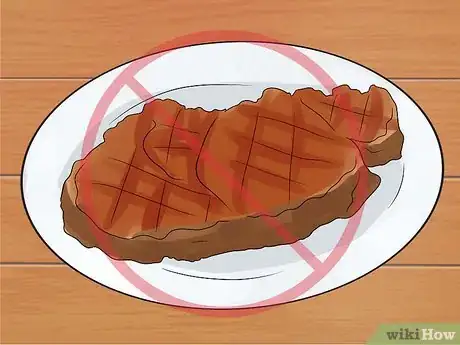This article was co-authored by Katie Rhodes-Smith RD, MS. Katie Rhodes-Smith is a Registered Dietitian and is the founder of OWN-Nutrition, LLC, a nutrition planning business for athletes based in Little Rock, Arkansas. Katie received her MS in Clinical Nutrition from the University of Arkansas for Medical Sciences. She is board certified Specialist in Sports Dietetics.
This article has been viewed 30,569 times.
Inflammation is a normal process that occurs in your immune system. It helps your body respond to infecting organisms like viruses or parasites and promotes tissue repair and healing in your body. But acute inflammation and chronic inflammation can cause severe allergic reactions, such as asthma attacks, and chronic infections or health issues.[1] Inflammation can be triggered by inflammatory foods, which are foods that contain elements your body perceives as foreign or threatening. You can avoid inflammatory foods and add more anti-inflammatory foods to your diet to help lower your risk of inflammation.
Steps
Recognizing Anti-Inflammatory Foods
-
1Cook with olive oil or sunflower oil. Opt for healthier oils like olive oil, grapeseed oil, borage oil, avocado oil, or safflower oil when you are cooking.[2] [3]
- Try to cook your foods at low temperatures, such as a low simmer or medium to low heat. Using anti-inflammatory oils at low cooking temperatures usually makes for healthier meals.
-
2Look for leafy green vegetables. Add leafy green vegetables like spinach, mustard greens, collard greens, kale, broccoli, Swiss chard, turnips, and beet greens to your diet. These vegetables are full of vitamins and minerals. They are also anti-inflammatory. You should aim to have at least one leafy vegetable per meal.[4] [5]
- Beets, celery, cabbage, carrots, peas, bok choy, and Brussels sprouts are also good anti-inflammatory vegetables.
- Fresh tomatoes and tomato-based sauces are also considered anti-inflammatory.
- If you do not have access to fresh vegetables, you can use frozen vegetables. Check the packaging to make sure there isn't added sodium or sugar.
Advertisement -
3Consume a variety of fresh fruits. Go for apples, bananas, pineapples, strawberries, blueberries, blackberries, cherries, and oranges. These fruits all have anti-inflammatory properties. Try to have at least one anti-inflammatory fruit for every meal.[6] [7]
- If you do not have access to fresh fruits, you can have frozen fruits. You can then add these to smoothies to create a healthy, anti-inflammatory drink.
-
4
-
5
-
6Add herbs, nuts, and spices to your meals. Fresh herbs like basil, sage, and rosemary can all add anti-inflammatory properties to your meals. Foods like onions and garlic also have high anti-inflammatory properties and should be added to your diet.[12] [13]
- You should also use anti-inflammatory spices like turmeric, cayenne pepper, ginger, and cloves in your meals.
- Nuts, seeds, and spices are a great, simple way to add more anti-inflammatory foods to your diet. Sprinkle almonds, walnuts, or peanuts in your morning oatmeal or yogurt. Add pumpkin seeds, sunflower seeds, cashews, or sesame seeds to salads and curries. Season your meals with a pinch of cayenne or ginger.
-
7Drink green tea and herbal tea. Water is always the healthiest beverage but you can also have green tea and herbal tea to consume more anti-inflammatory liquids.[14] [15]
- You may want to read up on how to properly prepare green tea.
Avoiding Inflammatory Foods
-
1Avoid any foods that cause allergies. A food allergy is considered a specific form of inflammation, where your immune system has a negative response to a certain food. You should avoid eating any foods that cause allergies as this is a form of inflammation that can lead to serious health issues.[16]
- Peanut allergies and seafood allergies are common, but you may also suffer from other food intolerances or sensitivities, such as a gluten sensitivity or lactose intolerance.
- If you suspect you have an intolerance or allergy, try keeping a symptom journal. You can then pinpoint certain foods that you may want to remove as a trial. A doctor or dietitian can look at your journal to give a recommendation on what you could remove. Continue to journal and see if symptoms improve.
-
2Stay away from refined carbohydrates. Refined carbohydrates such as white breads, pastas, and baked goods can cause inflammation. Avoid these foods, especially if they are pre-packaged, as they likely contain additives and preservatives that are not good for you.[17]
- Though whole grain foods are less inflammatory than white breads, pastas, and baked goods, they will have some inflammatory effects. If these foods are made with organic whole grains with no additives or preservatives, they may be considered not inflammatory.
-
3Avoid fried foods. Stay away from fried foods, such as french fries or fried meats. In addition to being inflammatory, eating fried foods can also lead to other health issues like obesity and weight issues.
-
4Do not have processed meats or red meat. Stay away from the cold cuts aisle, as processed meats contain inflammatory properties.[18]
- Red meat is also considered an inflammatory food and should be consumed in moderation. Look for beef that is grass fed rather than grain fed, as grass fed beef has lower inflammatory properties.
-
5Avoid butter, margarine, shortening, and lard. These types of fats are high in inflammatory omega 6-fats. Try to cook with healthier oils like olive oil or coconut oil and only use butter or margarine on toast in moderation.[19]
-
6Skip the soda and sugar-sweetened beverages. Soda and beverages sweetened with artificial flavors and sugars are considered inflammatory. Stick with water or other healthy beverages such as green tea or natural fruit juices.[20]
Selecting Alternatives to Inflammatory Foods
-
1Look for unprocessed foods. Processed and pre-packed foods that contain many ingredients that can be inflammatory. There are also ingredients that are added to foods during processing that can cause inflammation. Focus on foods that are unprocessed and not packaged.[21]
- Try shopping on the outer perimeter of the grocery store so you can avoid packaged foods like instant noodles, cookies, bottled sauces and cooking mixes. The more food you can prepare and cook yourself from scratch, the less processed and pre-packed ingredients you will consume.
-
2Go for fresh, whole foods. Whole foods are processed and refined as little as possible and should not cause inflammation. Check the labels of foods at the grocery store to confirm they contain very few basic ingredients and the ingredients are all natural.[22]
-
3Select foods with no additives or preservatives. Foods that do not contain additives or preservatives should not cause inflammation. Check food labels and the listed ingredients on food items to ensure there are no additives or preservatives.[23]
-
4Have brown rice and whole grains. Rather than have a meal with white rice or refined pasta, go for a meal with brown rice and whole grains like quinoa or couscous.
- You may want to read up on how to make quinoa properly and how to prepare brown rice.
References
- ↑ http://www.cdc.gov/pcd/issues/2012/11_0301.htm
- ↑ http://www.arthritis.org/living-with-arthritis/arthritis-diet/anti-inflammatory/anti-inflammatory-diet.php
- ↑ http://www.arthritis.org/living-with-arthritis/arthritis-diet/best-foods-for-arthritis/healthy-oils.php
- ↑ http://www.arthritis.org/living-with-arthritis/arthritis-diet/anti-inflammatory/anti-inflammatory-diet.php
- ↑ http://www.arthritis.org/living-with-arthritis/arthritis-diet/best-foods-for-arthritis/healthy-oils.php
- ↑ http://www.arthritis.org/living-with-arthritis/arthritis-diet/anti-inflammatory/anti-inflammatory-diet.php
- ↑ http://www.arthritis.org/living-with-arthritis/arthritis-diet/best-foods-for-arthritis/healthy-oils.php
- ↑ http://www.arthritis.org/living-with-arthritis/arthritis-diet/anti-inflammatory/anti-inflammatory-diet.php
- ↑ http://www.arthritis.org/living-with-arthritis/arthritis-diet/best-foods-for-arthritis/healthy-oils.php
- ↑ http://www.arthritis.org/living-with-arthritis/arthritis-diet/anti-inflammatory/anti-inflammatory-diet.php
- ↑ http://www.arthritis.org/living-with-arthritis/arthritis-diet/best-foods-for-arthritis/healthy-oils.php
- ↑ http://www.arthritis.org/living-with-arthritis/arthritis-diet/anti-inflammatory/anti-inflammatory-diet.php
- ↑ http://www.arthritis.org/living-with-arthritis/arthritis-diet/best-foods-for-arthritis/healthy-oils.php
- ↑ http://www.arthritis.org/living-with-arthritis/arthritis-diet/anti-inflammatory/anti-inflammatory-diet.php
- ↑ http://www.arthritis.org/living-with-arthritis/arthritis-diet/best-foods-for-arthritis/healthy-oils.php
- ↑ http://www.health.harvard.edu/staying-healthy/foods-that-fight-inflammation
- ↑ http://www.health.harvard.edu/staying-healthy/foods-that-fight-inflammation
- ↑ http://www.health.harvard.edu/staying-healthy/foods-that-fight-inflammation
- ↑ http://www.health.harvard.edu/staying-healthy/foods-that-fight-inflammation
- ↑ http://www.health.harvard.edu/staying-healthy/foods-that-fight-inflammation
- ↑ http://www.arthritis.org/living-with-arthritis/arthritis-diet/anti-inflammatory/anti-inflammatory-diet.php
- ↑ http://www.arthritis.org/living-with-arthritis/arthritis-diet/anti-inflammatory/anti-inflammatory-diet.php
- ↑ http://www.arthritis.org/living-with-arthritis/arthritis-diet/anti-inflammatory/anti-inflammatory-diet.php











































































